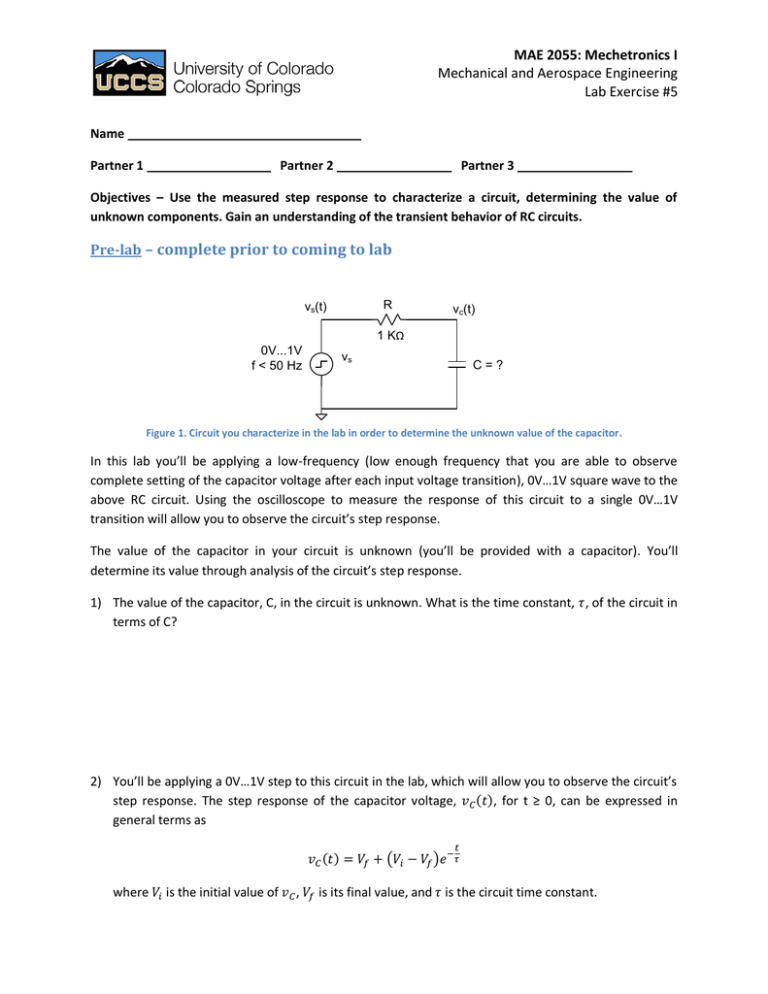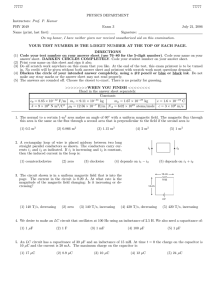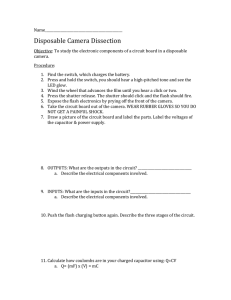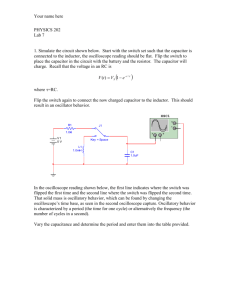MAE 2055: Mechetronics I Mechanical and Aerospace Engineering Lab Exercise #5
advertisement

MAE 2055: Mechetronics I Mechanical and Aerospace Engineering Lab Exercise #5 Name Partner 1 Partner 2 Partner 3 Objectives – Use the measured step response to characterize a circuit, determining the value of unknown components. Gain an understanding of the transient behavior of RC circuits. Pre-lab – complete prior to coming to lab R vs(t) vc(t) 1 KΩ 0V...1V f < 50 Hz vs C=? Figure 1. Circuit you characterize in the lab in order to determine the unknown value of the capacitor. In this lab you’ll be applying a low-frequency (low enough frequency that you are able to observe complete setting of the capacitor voltage after each input voltage transition), 0V…1V square wave to the above RC circuit. Using the oscilloscope to measure the response of this circuit to a single 0V…1V transition will allow you to observe the circuit’s step response. The value of the capacitor in your circuit is unknown (you’ll be provided with a capacitor). You’ll determine its value through analysis of the circuit’s step response. 1) The value of the capacitor, C, in the circuit is unknown. What is the time constant, , of the circuit in terms of C? 2) You’ll be applying a 0V…1V step to this circuit in the lab, which will allow you to observe the circuit’s step response. The step response of the capacitor voltage, , for t ≥ 0, can be expressed in general terms as where is the initial value of , is its final value, and is the circuit time constant. MAE2055 Mechetronics I Lab Exercise #5 Given what you know about the circuit (you know the values of everything but the capacitor) simplify this general expression for as much as possible. 3) Plot the step response, from 2). , for on the axes below. That is, plot your simplified expression Assume the 0V…1V transition of occurs at . Label initial and final values of (i.e., and . Label the time constant, , on the time axis, and show the value of the capacitor voltage after one time constant has elapsed, . What is the initial slope of ? Indicate this slope on your plot. vc(t) t 0 -2- MAE2055 Mechetronics I Lab Exercise #5 4) When you get into the lab, your job will be to determine the unknown value of the capacitor in your circuit. You will do this by taking two different types of measurements. Think about how you will do this, and read through the rest of the lab exercise before coming to the lab. ------------------------------------------ End of the pre-lab ------------------------------------------ Have your instructor initial here to verify completion of the pre-lab. ---------------------------------- To be completed in the lab ---------------------------------5) Build the circuit on your breadboard Connect the function generator to your circuit and set it to output a 0V...1V square wave with frequency lower than 50 Hz or so. Probe the capacitor voltage, , with the oscilloscope. Use an oscilloscope probe for this lab (i.e. not a BNC cable with alligator clips). 6) Set up the scope to display the full step response of the circuit on screen. (i.e., show the initial value of before the step, and show settling to its final value) 7) Using the scope, take measurements of the circuit’s step response. You can use the tracking cursors on the scope to help with your measurements. Measure the time constant as the time difference from the beginning of the transition of the capacitor voltage to the time at which it has transitioned through 63% of its full swing. What is the initial value of What is the final value of ? ? What is the circuit time constant? -3- MAE2055 Mechetronics I Lab Exercise #5 8) Plot the measured step response, as seen on the scope display, on the axes below, labeling the values measured in 7). Include the scope’s sweep speed and sensitivity settings as shown on the display as well. 9) Using the measured step response values (specifically the measured time constant), determine the value of the capacitor, C. Explain the process you use for determining C, and show all of your calculations. -4- MAE2055 Mechetronics I Lab Exercise #5 10) You will now use an alternate method for measuring the time constant. Recall that the initial slope of the RC step response is Measure the value of the initial slope of on the scope using the cursors. Use this measured value to determine the time constant, , and the value of the capacitor, C. Show your calculations below. NOTE: In order to make an accurate measurement of the initial slope, you’ll need to zoom in the time scale to focus on the beginning of the response. Also, setting the scope display to averaging mode will help. Try setting the number of averages to 256. These values should agree reasonably well with the values determined in 7) and 9). 11) Of the two methods you used to measure the circuit time constant and calculate the capacitor value, which is better? Why? -5-
![Sample_hold[1]](http://s2.studylib.net/store/data/005360237_1-66a09447be9ffd6ace4f3f67c2fef5c7-300x300.png)





